Choose The Best Guttering Material For Your Property
Gutters are essential to any property’s exterior, helping protect your roof, walls, and foundation from water damage. But with so many options for gutter system materials, it can be challenging to know which one is right for you.
At Thunder Bay Roofing, we specialize in helping homeowners and business owners in Edgewater and surrounding areas choose the best material and the perfect gutter system materials for their needs. Contact our Thunder Bay roofing company today by calling 410-956-7663 and receive a free estimate!
Aluminum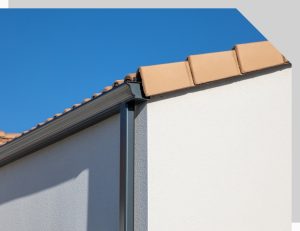
Upsides
Aluminum is one of the most popular materials for gutters, thanks to its affordability and durability. It’s also lightweight, making it easy to install. Aluminum gutters won’t rust or corrode, even in harsh weather conditions. These gutters come in various colors and can be painted to match your home’s exterior.
Downsides
Aluminum gutters are less durable than other materials and can easily dent or sustain damage from falling branches or debris. This means property owners may need to replace them more frequently, which adds to the cost of ownership. Aluminum gutters are also not as aesthetically pleasing as materials such as copper or zinc and may not complement certain architectural styles.
Copper
Upsides
Copper gutters are more durable than aluminum and can last up to 100 years with proper maintenance. Copper is highly rust-resistant, making it a great choice for areas with harsh weather conditions. They also develop a beautiful patina, that polished bronze look typical of copper providing aesthetic appeal and a protective layer.
Downsides
Copper gutters are costly and require professional gutter installation due to their premium nature. They can corrode over time, leading to leaks and water damage, and their weight can cause extra stress on the roof, which may not be suitable for older or weaker structures.
Steel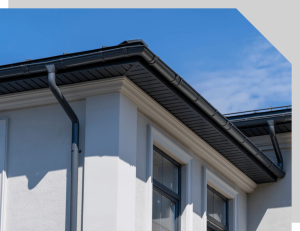
Upsides
Steel gutters are a cost-effective option compared to copper but still provide excellent durability. They are less susceptible to dents than aluminum gutters and are available in various colors. With proper maintenance, steel gutters can last 20 to 50 years, depending on the quality of the material and how well they are maintained.
Downsides
On the downside, steel gutters can be more expensive than other materials, especially if you opt for high-quality steel. Steel gutters are prone to rust and corrosion over time, which can lead to leaks and water damage. They’re also prone to denting and warping, affecting their structural integrity and ability to channel water away from your home.
Stainless Steel
Upsides
Stainless steel is resistant to rust and corrosion. Stainless steel gutters are highly durable and require minimal maintenance, making them a popular choice for homeowners who want long-lasting gutters that can withstand harsh weather conditions.
Downsides
Stainless steel gutters can be more difficult to install than other materials, requiring specialized equipment and expertise. This can add to the cost of the project and may make them less accessible for DIY installation. Additionally, stainless steel gutters may not be as aesthetically pleasing as other materials, as they have a more industrial look that may not complement certain architectural styles or home designs.
Vinyl
Upsides
Vinyl gutters are a cost-effective option for homeowners on a tight budget. They’re easy to install and are available in various colors, which can complement a home’s exterior. Vinyl gutters are also low maintenance, as they don’t rust or corrode, and don’t require regular painting or sealing.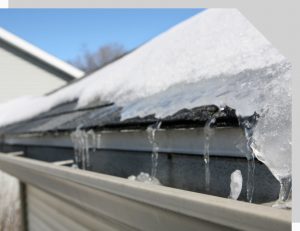
Downsides
Vinyl is the least durable gutter material. Gutters made of vinyl can crack or warp over time, especially in extreme temperatures. Additionally, vinyl gutters may not be as aesthetically pleasing as other materials and may look cheap or flimsy.
Zinc
Upsides
Zinc is a metallic material that’s highly durable and corrosion-resistant. This makes it a popular choice for gutters, as they’re exposed to moisture and weathering. Zinc gutters can last many years without needing to be replaced or repaired. Zinc gutters are environmentally friendly and can be recycled.
Downsides
It’s important to note that zinc’s durability, resistance to corrosion, and frequent unavailability make it more expensive than other materials. Zinc gutters may take on a chalky appearance over time, which may not be aesthetically pleasing for some homeowners. They also require professional installation and maintenance, which can add to the overall cost.
PVC
Upsides
PVC (polyvinyl chloride) is a plastic material that’s lightweight and inexpensive. PVC gutters are a low-cost option for homeowners, which can be an upside for those on a tight budget. They’re easy to install and require minimal maintenance.
Downsides
PVC gutters aren’t as durable as other materials and may not hold up well in extreme weather conditions. They can crack, warp, or sag over time, leading to leaks and water damage. Additionally, PVC gutters may not be as aesthetically pleasing as other materials, such as copper or aluminum, which can be concerning for property owners who value curb appeal.
Galvanized Steel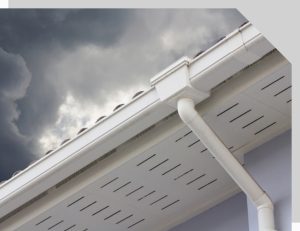
Upsides
Galvanized steel is a strong and durable material often used for gutters in areas with heavy rainfall or harsh weather conditions. It’s coated with a layer of zinc to make it resistant to corrosion. Galvanized steel gutters can last for many years with proper maintenance, which makes them a good choice for homeowners who want a long-lasting solution.
Downsides
On the downside, these gutters can be heavy and require professional installation, adding to the overall cost. Galvanized steel gutters can also be noisy during heavy rain, which can be a concern for some property owners. The zinc coating necessary to prevent rust and corrosion on these gutters may not be as eco-friendly as other materials, as they’re often coated with a layer of zinc, which can be harmful to the environment.
Wood
Upsides
Wood gutters were once popular due to their natural look and feel. They can be custom-fabricated to fit the dimensions and contours of your home, providing a more precise fit and better performance than prefabricated gutters. Some types of wood, such as redwood or cypress, are naturally rot-resistant and can withstand exposure to the elements without deteriorating.
Downsides
Wood gutters require much maintenance, including frequent cleaning, sealing, and painting. They’re also susceptible to rot and decay, which can lead to leaks and other problems. Another potential downside of wood gutters is their cost. Wood gutters are generally more expensive than other gutters, particularly if you opt for high-end materials like cedar or redwood.
Fiberglass
Upsides
Fiberglass gutters have become increasingly popular due to their durability, lightweight design, and resistance to harsh weather conditions. Their lightweight construction makes them an excellent option for areas with heavy rainfall, where the weight of traditional gutter systems can be a concern. Fiberglass gutters are highly resistant to rust and corrosion, which can significantly extend their lifespan and reduce the need for frequent maintenance.
Downsides
One of the downsides of fiberglass gutters is their availability. They may not be as widely available as other materials, making it harder to find a qualified installer or replacement parts if needed. Fiberglass gutters can also be more expensive than other materials due to their relative scarcity and the specialized manufacturing processes required to produce them.
Zinc-Aluminum
Upsides
Zinc-aluminum gutters are a newer material that combines the benefits of zinc and aluminum. They’re lightweight, durable, and resistant to corrosion. These gutters are also relatively easy to install and maintain. Zinc-aluminum gutters can be a good choice for homeowners who want a long-lasting, low-maintenance option.
Downsides
Zinc-aluminum gutters may expand and contract more than other materials in response to temperature changes. This can cause the gutters to warp or buckle over time, which can compromise their effectiveness and require costly repairs or replacement. Zinc-aluminum gutters may not be as widely available as other materials.
Hybrid Materials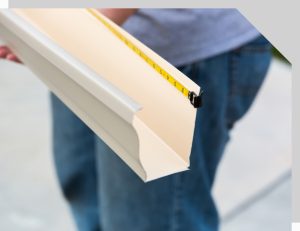
Upsides
Hybrid material gutters offer several benefits to property owners, including durability and aesthetic appeal. These gutters combine the advantages of two materials to create a product that can withstand harsh weather conditions while maintaining a stylish appearance. For example, vinyl-coated aluminum gutters resist corrosion and rust, while copper-clad steel gutters provide a beautiful and timeless look.
Downsides
Hybrid material gutters can be more expensive than traditional gutters made of a single material. The manufacturing process involved in combining different materials can be time-consuming and costly. Additionally, these gutters may not be as widely available as traditional materials, which could make installation more difficult and expensive for some homeowners.
Cast Iron
Upsides
Cast iron gutters are a strong and durable option that can withstand extreme weather conditions and resist corrosion. With proper care and maintenance, cast iron gutters can last for many years, often up to 50 years or more.
Downsides
Cast iron gutters are heavier than other materials, making them more difficult to install. They also require regular painting to prevent rust and other damage. Due to these factors, cast iron gutters are less commonly used today than in the past and may not be as readily available as other gutter materials.
Polymer
Upsides
Polymer gutters offer a lightweight and flexible alternative to traditional materials like cast iron. They are resistant to rust, corrosion, and fading, making them suitable for various climates and environments. Additionally, polymer gutters are relatively easy to install due to their lightweight nature, reducing labor costs and installation time.
Downsides
While polymer gutters are durable, they may not have the same lifespan as materials like cast iron. Depending on the quality of the polymer and the environmental conditions, they may degrade over time, requiring replacement sooner than other materials. Additionally, some homeowners may find the appearance of polymer gutters less appealing compared to traditional options like metal or wood.
Concrete Gutters
Upsides
Concrete gutters, also known as concrete channel drains or trench drains, are renowned for their strength and durability. They provide excellent resistance to weathering, corrosion, and impact, making them ideal for heavy-duty applications and areas with high traffic.
Concrete gutters are also highly customizable, allowing various shapes and sizes to be installed to suit specific roof drainage needs. With proper installation and regular maintenance, concrete rain gutters can last for decades without significant degradation.
Downsides
One of the main drawbacks of concrete gutters is their weight and bulkiness, which can make installation challenging and labor-intensive. Transporting and maneuvering concrete gutter sections require heavy machinery and skilled labor, adding to the cost of the project.
Additionally, concrete gutters may be prone to cracking or shifting over time, especially in regions with freeze-thaw cycles or seismic activity. Repairing or replacing damaged sections of concrete gutters can be costly and time-consuming.
Stone
Upsides
Stone gutters exude timeless elegance and charm, adding a touch of sophistication to any property. Quarried from natural stone such as granite, limestone, or sandstone, these gutters offer exceptional durability and weather resistance. Stone gutters can withstand harsh environmental conditions, including extreme temperatures, heavy rainfall, and UV exposure, without deteriorating or fading. Additionally, their rugged appearance blends seamlessly with traditional and rustic architectural styles, enhancing the aesthetic appeal of residential and historical buildings.
Downsides
Despite their durability and aesthetic appeal, stone gutters present several challenges. Firstly, the weight of stone gutters can pose logistical difficulties during transportation, handling, and installation. Specialized equipment and skilled labor are often required to maneuver and secure heavy stone sections.
Furthermore, the cost of stone gutters tends to be higher than alternative materials, making them less accessible for budget-conscious homeowners. Additionally, stone gutters may require periodic maintenance, such as resealing joints or repairing cracks, to ensure optimal performance and longevity.
Titanium 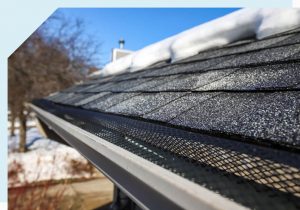
Upsides
Titanium gutters offer unparalleled strength and durability, surpassing many other materials in resilience and longevity. Known for their exceptional corrosion resistance, titanium gutters can withstand even the harshest environmental conditions without rusting or deteriorating.
Their lightweight yet sturdy construction makes installation easier than heavier materials like cast iron or concrete gutter systems. Additionally, titanium gutters require minimal maintenance, enhancing their appeal for homeowners seeking a long-lasting gutter solution.
Downsides
Despite their impressive qualities, titanium gutters come with a higher price tag than more conventional materials like aluminum or steel. This upfront cost may deter some homeowners, particularly those on a tight budget.
Additionally, titanium gutters may not be as readily available as other options, making sourcing and installation potentially more challenging among homeowners everywhere. However, for those prioritizing durability and performance, the investment in titanium gutters can be worthwhile in the long run, offering peace of mind and protection for your property.
Frequently Asked Questions
Your roofing contractor might sometimes recommend against using wood, vinyl, and copper. Wood is not often a practical material for guttering due to its susceptibility to rot and decay, especially when exposed to moisture.
Vinyl can become brittle and may not hold well under heavy rainfall or extreme weather conditions. Copper is also quite expensive and can be prone to developing a patina or discoloration over time, which may not be desirable for all homeowners.
Yes, high-quality, common gutter materials can add value to your home by improving its functionality and overall appearance. Newer, more durable gutter materials may be more appealing to potential buyers if you decide to sell your home.
Aluminum gutters typically require the least maintenance compared to other gutter materials like steel or vinyl. Aluminum is resistant to corrosion and does not rust, making it a low-maintenance option. Additionally, aluminum gutters are lightweight and durable, further reducing maintenance needs. Overall, aluminum is generally considered the gutter material that requires the least ongoing upkeep.
For gutters that need to handle heavy rainfall, aluminum or galvanized steel are typically the best options. Aluminum gutters are durable and can withstand the weight and force of heavy rain without sagging or collapsing.
Galvanized steel gutters are also a sturdy choice that can efficiently manage large volumes of water. Both aluminum and galvanized steel are more heavy-duty materials well-suited for areas with intense precipitation.
